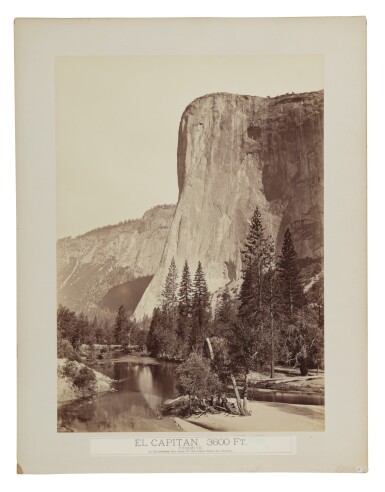
Property of an Important Midwestern Collection
Carleton E. Watkins
'El Capitan. 3600 Ft. Yosemite'
Lot Closed
April 7, 04:43 PM GMT
Estimate
40,000 - 60,000 USD
Lot Details
Description
Property of an Important Midwestern Collection
Carleton E. Watkins
1829 - 1916
'El Capitan. 3600 Ft. Yosemite'
mammoth-plate albumen print, mounted, the photographer’s letterpress label, with the title, series number '828,' series title, and his ‘427 Montgomery Street, San Francisco’ studio address, affixed to the mount, a 'Gordon L. Bennett Collection' stamp on the reverse, framed, 1878-81
image: 21 ¼ by 15 ⅛ in. (54 by 38.4 cm.)
frame: 34¼ by 27¾ in. (87 by 70.5 cm.)
Sotheby's New York, The Gordon L. Bennett Collection of Carleton Watkins New Series Photographs of Yosemite, 28 April 2004, Sale 7966, Lot 56
Monterey Museum of Art, Carleton E. Watkins: Yosemite Photographs, Courtesy of Gordon L. Bennett, June – September 1993
In his' 1861 view of this massive rock formation, Watkins also used the Indian name, Tutocanula. In his research on Yosemite place names, Peter Browning discusses differing interpretations of this Indian word, among them one referring to ‘a Sandhill Crane, a chief of the First People’; and a Spanish translation, El Capitan, meaning ‘the Rock Chief’ (op. cit., p. 38).
Watkins’s ‘Old Series’ mammoth-plate of the same scene was made from close to the same spot. But in a photograph made circa 1865-66, and in the ‘New Series’ photograph offered here, the camera’s view is more encompassing, and the frame includes not only the sand bar at the bottom of the photograph, but also a significant amount of sky above El Capitan at the top. The sand bar’s old trees in the earlier view, which obscure the lower half of the rock, are gone in the present view, and as with other ‘New Series’ pictures, the photograph is now more consciously composed.
Like the Vernal Fall, El Capitan has been photographed over the decades by a number of photographers using a similar vantage point. From Weed, Muybridge, and Fiske, to Ansel Adams, the photographs communicate the essential majesty of the rock that seems never to have changed.
You May Also Like










